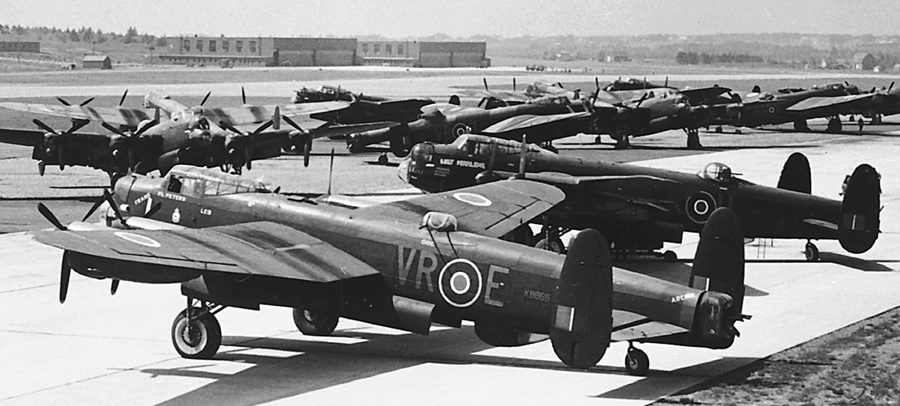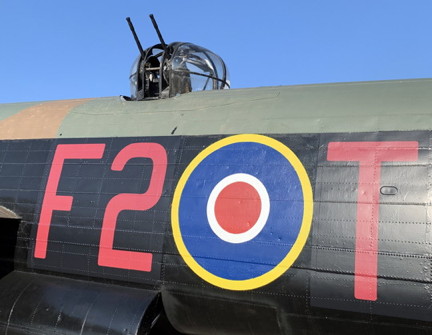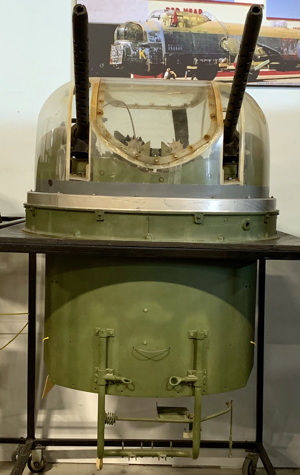 Bomber Command
Bomber Command  |
Aircrew Chronicles
|
Aircrew Losses
|
Nose Art
|
BCATP
|
|
Aircrew Chronicles
|
Aircrew Losses
|
Nose Art
|
BCATP
|
 Lancaster
Lancaster  |
Media
|
Media
 Bomber Command
Bomber Command  |
Aircrew Chronicles
|
Aircrew Losses
|
Nose Art
|
BCATP
|
|
Aircrew Chronicles
|
Aircrew Losses
|
Nose Art
|
BCATP
|
 Lancaster
Lancaster  |
Media
|
Media
All Lancaster bombers carried front, mid-upper, and rear gun-turrets except for a few special operations such as the Dams Raid and when carrying the Grand Slam bombs. Mid-upper turrets were mounted on top of the aircraft, about mid-way down the fuselage.
Almost all Bomber Command turrets had no armour and light, low-calibre guns. American designed bombers carried more air-gunners, heavy, high-calibre guns, and their turrets were armour-plated. Although they could not defend themselves as well as the American bombers, Bomber Command aircraft were able to carry significantly heavier payloads to their targets.

The turret currently mounted on the Bomber Command Museum of Canada's Lancaster is a British-built, Frazer-Nash FN-50 mid-upper turret. The turret that was initially installed on the aircraft when it was built in 1945 is an American-built, Martin 250 CE. They are very different.
 on the museum's Lancaster. |
The Frazer-Nash turret contains two, light .303 Browning machine guns that were fed from two ammunition boxes that each held 1000 rounds. The turret is hydraulically powered by the starboard-outer engine. Virtually all Lancasters that flew Bomber Command operations were equipped with FN-50 turrets as were Stirling Mk. III bombers. The bulbous shape of the Frazer-Nash created more drag but provided good visibility. The FN-50 had a sling type seat and there was no protection for the air-gunner. The Frazer-Nash turret mounted on the museum's Lancaster is operational but is not currently connected to a hydraulic power source. |
The Martin turret is electrically powered (24 volt), contains two, heavy .50 calibre machine guns, and is much more robust in its construction. Four ammunition boxes each carried 200 rounds of ammunition. American bombers such as the B-24 Liberator and B-26 Marauder carried Martin turrets. There is a large piece of armour-plating to protect the air-gunner, although his view was quite limited. When mounted on Lancasters, the Martin turret, because of its greater weight, was placed much closer to the wing than the Frazer-Nash. So, the Frazer-Nash turret currently on the museum's Lancaster has been placed, technically incorrectly, at the location formerly occupied by the Martin turret when the aircraft was built. All but one of the first 155 of the 430 Canadian-built Lancasters carried Frazer-Nash mid-upper turrets. Lancaster KB783 was trial fitted with the Martin turret. The last 275 Lancasters (from serial # KB855 to KB999 and FM100 to FM229), including our museum's aircraft, were fitted with Martin turrets. The plexiglass cupola on KB763 was of a different design to the one introduced with KB855 and subsequent Canadian Lancasters. Very few, if any, shots were fired in anger by Martin-equipped Lancasters. The Martin turret on display at the museum is from a 420 Squadron RCAF Lancaster that was scrapped at Pearce, Alberta. The turret moves with its manual control handles, but the electrical components are not operational. |
 on display at the museum. |